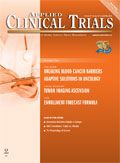FDA, Sponsors Look to Expand Patient Input to Clinical Trials
Applied Clinical Trials
Patient focused drug development is playing a larger role in study design and outcome measurement.
Patient focused drug development (PFDD) is moving into the mainstream, promising to alter the conduct of clinical trials and FDA regulatory policies. PFDD appears increasingly useful and accepted in designing studies and in assessing outcomes and treatment benefits most important to patients with a certain condition. Building on the experience gained from a series of FDA meetings to solicit patient perspectives for treating chronic conditions, sponsors are querying patient groups to help define the key goals of clinical studies and to avoid research programs that yield less useful results. FDA is bringing in patients to consult with review divisions and to join FDA-sponsor meetings to help shape research studies and product labeling.
To further this trend, FDA is expanding its patient representative program beyond participation in advisory committee meetings. The agency has identified some 200 patient representatives based on their experience, FDA training, and clearance on conflicts of interest. Last year, members of this cadre were involved in 10 consultations with FDA review divisions and in additional meetings with sponsors, explained Richard Klein, head of FDA's patient liaison program in the Office of Health and Constituent Affairs. Qualified patient representatives not only have experience with a disease or condition, but are active in patient advocacy organizations, knowledgeable about treatment options, and able to grasp basic scientific principles, Klein pointed out at the recent conference on PFDD sponsored by the University of Maryland Center of Excellence in Regulatory Science & Innovation.
One FDA initiative is to develop a "roadmap" to patient-focused outcome measurement in clinical trials, reported Ashley Slagle of the Office of New Drug (OND) Study Endpoints and Labeling Development staff in the Center for Drug Evaluation and Research (CDER). The roadmap aims to establish an orderly pathway for selecting or developing instruments to accurately measure treatment benefit, she explained. Key criteria are the natural history of the disease or condition, the affected patient population, treatment alternatives, and current care standards.

Improving Relationships and Diversifying the Site Selection Process
April 17th 2025In this episode of the Applied Clinical Trials Podcast, Liz Beatty, co-founder and chief strategy officer, Inato, discusses a number of topics around site engagement including community-based sites, the role of technology in improving site/sponsor relationships, how increased operational costs are impacting the industry, and more.
Behind the Buzz: Why Clinical Research Leaders Flock to SCOPE Summit
February 7th 2025In this episode, we meet with Micah Lieberman, Executive Conference Director for SCOPE Summit (Summit for Clinical Ops Executives) at Cambridge Innovation Institute. We will dive deep into the critical role of collaboration within the clinical research ecosystem. How do we bring together diverse stakeholders—sponsors, CROs, clinical trial tech innovators, suppliers, patients, sites, advocacy organizations, investors, and non-profits—to share best practices in trial design, program planning, innovation, and clinical operations? We’ll explore why it’s vital for thought leaders to step beyond their own organizations and learn from others, exchanging ideas that drive advancements in clinical research. Additionally, we’ll discuss the pivotal role of scientific conferences like SCOPE Summit in fostering these essential connections and collaborations, helping shape the future of clinical trials. Join us as we uncover how collective wisdom and cross-industry partnerships are transforming the landscape of clinical research.
Landmark Phase III Trial Shows Keytruda Significantly Improves Event-Free Survival in LA-HNSCC
April 28th 2025Interim KEYNOTE-689 trial data show that perioperative Keytruda significantly lowers the risk of disease progression or recurrence in resectable, locally advanced head and neck squamous cell carcinoma, marking the first major clinical advance for this patient population in more than two decades.